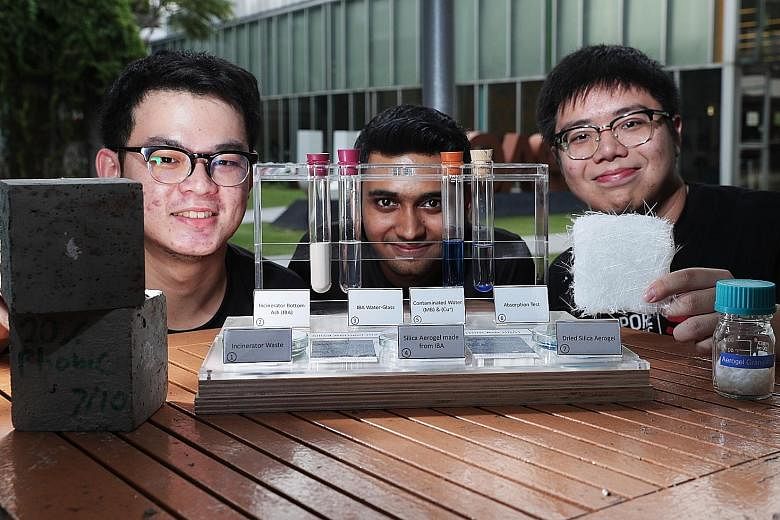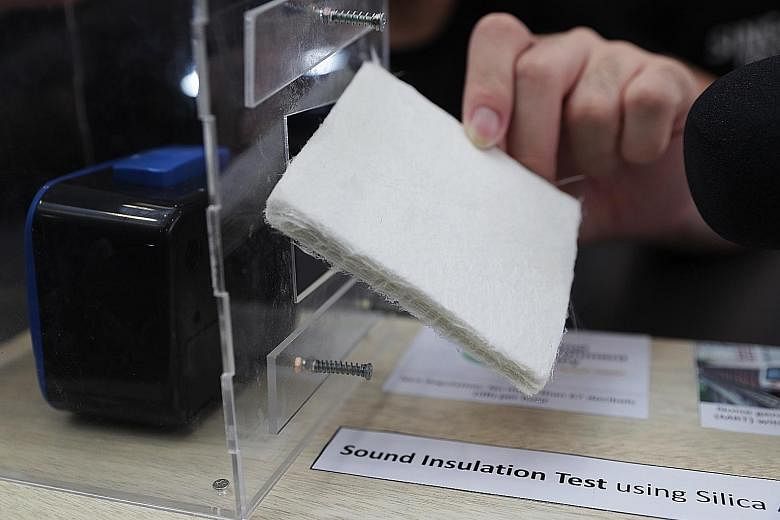At a time when Singapore is trying to find new methods to manage its waste and extend the life of Semakau Landfill, a team of students and researchers from Singapore Polytechnic (SP) has found a way to turn trash into treasure.
Civil Engineering with Business students Sakalesh Ashoka Rugi, 20, and Nicolaus Syaiful and Jordan Lim, both 19, discovered that incinerated bottom ash (IBA), which is the by-product of incinerating waste, could be turned into an aerogel.
Aerogels are among the world's lightest solid materials with extremely low density and thermal conductivity.
Mr Sakalesh said on Wednesday that aerogels are typically used in the aerospace industry, and have been used by the National Aeronautics and Space Administration to make spacesuits.
But the team's aerogel, which takes about one to two weeks to make from IBA, can be put to four different uses: as a replacement for sand in concrete, a water decontaminant, a sound barrier and a thermal blanket.
The trio's research was conducted as part of an internship with SP's Advanced Materials Technology Centre, under the supervision of Dr Handojo Djati Utomo, a civil engineering lecturer; Dr Li Xiaodong, a research scientist and Ms Lu Yanru, a research engineer.
Dr Handojo said the centre had already been working for the past three years on developing aerogels as a water decontaminant, using different materials.
The IBA, obtained from Tuas Incineration Plant, is put through physical and chemical processes to transform it into a powdery substance known as silica aerogel.
When placed in contaminated water, it is able to absorb contaminants such as oil and dyes. The contaminated aerogel can be cleansed using an extraction and distillation process and re-used multiple times.
Dr Handojo said this is a novel use of aerogel, as the water treatment industry is currently not using it for this purpose.
However, the three students also realised that the properties of the aerogel allowed it to be used for other purposes. When combined with glass fibre, the material acts as a good thermal and sound barrier. It is able to reduce sound levels by 12.5 per cent, and temperature by about 60 per cent to 65 per cent.
When used to replace 20 per cent of the sand in concrete, it results in concrete blocks that are 6.1 per cent lighter and have lower thermal conductivity. This means that the material is easier to transport and can keep the interior of buildings cooler than regular concrete.
Although the hybrid concrete is not as strong as regular concrete, it can still be used for non-structural purposes such as building facades or roofing, said Dr Handojo.
Developing the aerogel and its various products has not been easy.
The students had to juggle schoolwork and examinations, spending about five to six hours every weekday working on the project.
They also had to go back to school every day during the holidays to continue working on their product.
But it was a rewarding experience. Mr Lim said: "It's quite daunting, but it's a good opportunity not many students get."
The team is in the early stages of getting funding from SP to build a pilot plant to produce the thermal blanket on a larger scale, and is in talks with a company to commercialise it.
It is also searching for partners to further develop and commercialise the aerogel's other uses.
Mr Sakalesh said the team also hopes its innovations can be applied on a national level.
"We want to solve the national problem of Semakau Landfill filling up, so if we can push for it, we definitely will."



